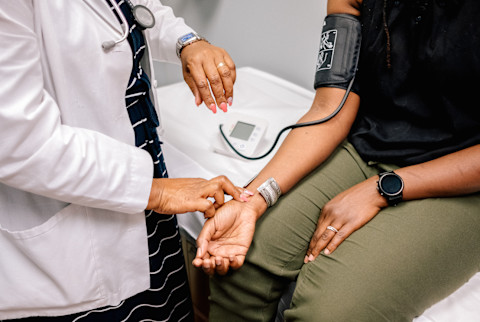People With Frequent Hot Flashes Are 50% More Likely To Get Cardiovascular Disease

Marked by sudden overheating, sweating, flushed skin, a racing heart, anxiety, and even chills, hot flashes are arguably the most notorious symptom of the menopause transition.
They’re incredibly common: 80% of people who undergo menopause experience vasomotor symptoms (VMS)—i.e., hot flashes and night sweats—an average of 4-5 times per day for approximately seven years, per the Obstetrics and Gynecology Clinics of North America. And for a lucky 25% of women in menopause, hot flashes are severe and last up to nine years (how fun).
Despite how disruptive they can be, hot flashes have long been billed as a normal part of the menopause transition that doesn’t require medical intervention. (Though there are some treatments available to ease symptoms.)
But according to a 2021 study from the Journal of the American Heart Association (JAHA), hot flashes are linked to an increased risk of cardiovascular disease (CVD), the leading cause of death for women. Here’s what the research found (plus, how you can care for your heart if you’re at risk).
What do hot flashes have to do with heart health?
Experts have long observed that for women, cardiovascular disease risk increases after menopause, following hormonal shifts and changes in body composition. The first year after one’s final period is marked by higher total cholesterol1, LDL (aka "bad" cholesterol), and apolipoprotein B (an oft-used biomarker for CVD risk2).
And while various demographic and behavioral factors have been studied for correlations, the 2021 JAHA study used data from the Study Of Women Across the Nation (SWAN), a multi-site longitudinal epidemiological study, and found that hot flashes may serve as another marker of CVD risk.
What the JAHA study reveals about hot flashes and CVD risk
The JAHA study followed over 3,000 women in their 40s and 50s over 22 years. At each visit, participants answered a questionnaire about the frequency and severity of any hot flashes they’d experienced in the prior two weeks. They also reported any cardiac events and submitted related medical records to be reviewed by independent cardiologists.
Researchers found that people who reported frequent hot flashes at the start of the study were 50% more likely to have CVD later on. Additionally, those whose frequent hot flashes persisted (for an average of four annual visits) had a 77% increased risk of cardiovascular disease. When controlling for demographic, risk factors, and even the use of hormone therapy, the connection persisted.
Interestingly, people who were Black, had little education, or experienced financial hardship were more likely to report frequent hot flashes. In other research, Black women were also found to be more likely to report VMS than women of other racial groups.
There’s no consensus as to why hot flashes are linked to an increased risk of CVD, though one study from Obstetrics & Gynecology observed that people who report hot flashes have higher LDL, HDL, apolipoprotein A-1, apolipoprotein B, and triglycerides than those who do not. Another study using earlier data from SWAN also found that people with hot flashes scored higher on the HOMA index3, a measure of insulin resistance.
What all this research means
Menopause is marked by an increased risk of cardiovascular disease. The 2021 JAHA study zeroed in on a group that may be at an elevated risk: those who experience frequent hot flashes.
These findings highlight the importance of prioritizing heart health leading up to and during menopause—especially for Black women, who are most likely to report frequent hot flashes.
How to care for your heart as you age
Prioritize movement
Exercising regularly is such ubiquitous advice that it can be easy to forget what critical benefits it brings. In a 2018 study from the Journal of the American Heart Association, women who exercised long enough to burn more than 500 calories per week (about one hour of jogging, depending on speed and weight ) had a 73% lower risk of CVD than women whose weekly exercise burned fewer than 500 calories.
In another study of over 7,000 women, those who did resistance training (i.e., lifting free weights or using weight machines) had significantly lower CVD risk4 (in addition to lower levels of fasting glucose, cholesterol, and body fat) than those who didn’t. Importantly, these benefits were observed in participants with obesity, showing that exercise has broad health benefits independent of weight loss.
Don’t smoke
While a slew of potential risk factors have been studied with mixed results, one that shows consistent correlation is the link between smoking and hot flashes. In fact, current smokers are 60% more likely to report VMS than nonsmokers, even when other risk factors are adjusted for.
Take a heart health supplement
And for people with the MTHFR gene variant (i.e., approximately half of the U.S. population) who have difficulty converting folate into an active form their body can use, methylated folate is a must. For a list of supplements featuring these star ingredients (all vetted by a nutrition Ph.D.) check out our heart health supplement roundup.
The takeaway
Cardiovascular disease is the leading cause of death for women, and the risk of developing CVD increases during menopause. Research conducted over the past few years shows that people who experience hot flashes are at an even greater risk.
Luckily, there’s plenty you can do to protect your heart, including moving your body regularly, avoiding smoking, and considering a daily heart health supplement. For our nutrition scientist’s favorites, check out this roundup of heart health supplements.
7 Sources
- https://www.jacc.org/doi/abs/10.1016/j.jacc.2009.10.009
- https://www.ncbi.nlm.nih.gov/pmc/articles/PMC8540246/
- https://academic.oup.com/jcem/article/97/10/3487/2833955
- https://www.ncbi.nlm.nih.gov/pmc/articles/PMC4369452/#:~:text=Women%20reporting%20resistance%20exercise%20had,fasting%20glucose%20and%20total%20cholesterol.
- https://www.ncbi.nlm.nih.gov/pmc/articles/PMC6903779/
- https://pubmed.ncbi.nlm.nih.gov/34068578/
- https://www.mdpi.com/1422-0067/20/9/2155
